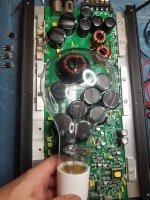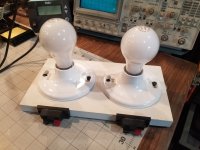Twist/push/pull on the power transformer to see if the amp ever starts to draw excessive current.
Do you have a couple of incandescent lamps that you could install in series with one positive rectifier and one negative rectifier to see if the amp will come up and produce audio?
The lamps should prevent excessive current if there is a bad cap or other secondary problem.
Do you have a couple of incandescent lamps that you could install in series with one positive rectifier and one negative rectifier to see if the amp will come up and produce audio?
The lamps should prevent excessive current if there is a bad cap or other secondary problem.
What wattage bulbs would you recommend? Are the two rectifiers on the left for one polarity and the two on the right for the other polarity? Without a schematic I've been in the dark. Will they need to be clamped for this test. This issue arised once I shorted pins 5 and 6 of one of the octocouplers. Do you think the xformer could have came loose or the insulation was compromised? I didnt smell any lacquer burning or see any smoke.
With amp on in it's current state if I grab and move the xformer around I can make the pitch of the whine change. It will jump up from let's just say 7khz to say 12khz as I pry it side to side. Then when I let it go it allmost sounds like its surging.
The attached has a supply similar to the drive and protection circuit in your amp. I don't have anything better that I can post.
Use the cathode of D445 and the anode of D447.
Any wattage.
If the transformer had a short, the current would have spiked.
Use the cathode of D445 and the anode of D447.
Any wattage.
If the transformer had a short, the current would have spiked.
Attachments
Could I just put a bulb in series with the b+? It sure would be a lot easier. I have big bulbs for diagnosing big ss amplifiers. This is a 500 watt bulb. Would this be bad for this amplifer? I know the caps would take longer to charge up but I just dont know with this amplifier.
Attachments
There could be a problem with the rail caps or something beyond the rectifiers. I do all I can do to prevent blowing parts and the two lamps are the safest.
I have a couple of 500w lamps but I use the slim halogen types that go in worklights.
I have a couple of 500w lamps but I use the slim halogen types that go in worklights.
I tested all the rail caps they tested good with low esr. Also the amp powered up fine (besides the outputs wich were out of circuit) before I shorted the probes on the one octocoupler. Is there anything up or downstream of that I should be checking. I did take a bunch of the resistor measurements in that area and they all seem spot on. Can i see if the octocoupler is working right without the rectifiers in?
Did you check the rail caps at full rail voltage?
The square transformer on the corner of the board produces the various regulated voltages and the supply for one of the optocoupler regulators so the rail supply isn't needed for those. The other opto has its regulated voltage from the negative rail so rail is needed for it.
The square transformer on the corner of the board produces the various regulated voltages and the supply for one of the optocoupler regulators so the rail supply isn't needed for those. The other opto has its regulated voltage from the negative rail so rail is needed for it.
I want to check the one I shorted. The one closer to the edge of the board. It passed the same diode test the other one did, that doesn't allways convince me it's good. I've seen weird stuff in new and old gear
That sounds about right ahha. I have tons of incondecent 12 volt bulbs in my tool box. Il have to dig some out tomarow.
You need something that can withstand the rail voltage. A 12v lamp is likely to fail immediately.
Understood. I didnt know it was that high. Il get some bulbs hopefully tomarow and get them wired in there.
That's what I plan to do. I just dont have two bulb sockets laying around so il just solder wires to the bottom of the bulbs or pick up sockets. Il get matching bulbs also because I'm a weirdo like that and it will make it easier to see any differences in current draw between the two.
- Home
- General Interest
- Car Audio
- MTX 1501D repair help

